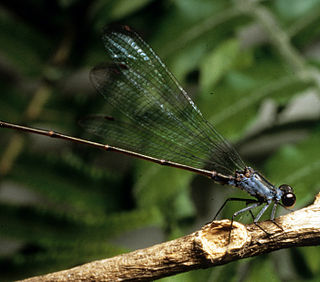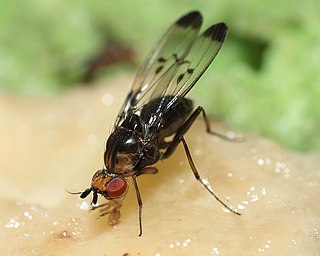
Drosophila is a genus of flies, belonging to the family Drosophilidae, whose members are often called "small fruit flies" or pomace flies, vinegar flies, or wine flies, a reference to the characteristic of many species to linger around overripe or rotting fruit. They should not be confused with the Tephritidae, a related family, which are also called fruit flies ; tephritids feed primarily on unripe or ripe fruit, with many species being regarded as destructive agricultural pests, especially the Mediterranean fruit fly.

The nene, also known as the nēnē or the Hawaiian goose, is a species of bird endemic to the Hawaiian Islands. The nene is exclusively found in the wild on the islands of Oahu, Maui, Kauaʻi, Molokai, and Hawaiʻi. In 1957, it was designated as the official state bird of the state of Hawaiʻi.

The Hawaiian crow or ʻalalā is a species of bird in the crow family, Corvidae, that is currently extinct in the wild, though reintroduction programs are underway. It is about the size of the carrion crow at 48–50 cm (19–20 in) in length, but with more rounded wings and a much thicker bill. It has soft, brownish-black plumage and long, bristly throat feathers; the feet, legs and bill are black. Today, the Hawaiian crow is considered the most endangered of the family Corvidae. They are recorded to have lived up to 18 years in the wild, and 28 years in captivity. Some Native Hawaiians consider the Hawaiian crow an ʻaumakua.

Megalagrion leptodemas, commonly referred to as the Crimson Hawaiian damselfly, is one of the rarest and most endangered Megalagrion species that is endemic to the island of Oahu in Hawaii. It is currently labeled as endangered by the ESA and critically endangered on the IUCN Red List. The general biology of Crimson Hawaiian damselflies is similar to other narrow-winged damselflies. Megalagrion leptodemas used to be found in the mountains of Ko’olau and Wai'anae but is now only found in four watersheds in the Ko’olau Mountains. The species is threatened by habitat loss and non-native species. They have limited habitat and small, scattered populations which can affect their future population stability. Conservation efforts for this species should concentrate on both habitat management and control of invasive species.

Megalagrion nesiotes is a species of damselfly in the family Coenagrionidae. Its common name is flying earwig Hawaiian damselfly. In the past, the flying earwig Hawaiian damselfly lived on the islands of Hawaii and Maui, in the U.S. state of Hawaii. Currently, there is only one population left in east Maui. Limited distribution and small population size make this species especially vulnerable to habitat loss and exotic species invasion. The flying earwig Hawaiian damselfly was last found in 2005. Little is known about this species because of the lack of observation. In 2010, the species was federally listed as an endangered species in the United States.

The Pacific Hawaiian damselfly, Megalagrion pacificum, is a species of damselfly that is native to Hawaiian streams and wetlands at low elevations. They are predaceous and territorial narrow-winged damselflies that can be identified by their abdominal markings. In the last century, the populations of Pacific Hawaiian damselflies have decreased due to invasive species, habitat loss, climate change, stream alteration, and urban development. The species was listed as an endangered species under the Endangered Species Act on July 26, 2010.

Drosophila silvestris is a large species of fly in the family Drosophilidae that are primarily black with yellow spots. As a rare species of fruit fly endemic to Hawaii, the fly often experiences reproductive isolation. Despite barriers in nature, D. silvestris is able to breed with D. heteroneura to create hybrid flies in the laboratory.
Hirtodrosophila mycetophaga is a fairly large drosophilid fly, with a mean length of 4.0–4.5 mm. It has thus far only been found in Australia. It mates on bracket fungi, preferentially those with a lighter-colored surface in order to enhance mating displays. In addition to these physical displays, flies emit specific sounds in order to attract and ultimately copulate with females.

The Hawaiian Drosophilidae are a lineage of flies within the genus Drosophila. This monophyletic clade includes all of the endemic Hawaiian Drosophila and all members of the genus Scaptomyza, which contains both Hawaiian and non-Hawaiian species. The Hawaiian Drosophilidae are descended from a common ancestor estimated to have lived 25 million years ago. Species of Hawaiian Drosophilidae flies have been studied as models of speciation and behavioral evolution. Along with other members of the native Hawaiian ecosystem, the conservations status of many species of Hawaiian Drosophilidae is threatened by habitat loss and introduced predators, among other factors.
Drosophila hemipeza is an endangered species of Hawaiian fly in the family Drosophilidae. This species is a member of the planitiba subgroup of the picture-wing clade of Hawaiian Drosophila.
Drosophila aglaia is an endangered species of fly from Hawaii. This species is a member of the aglaia subgroup of the picture-wing clade of Hawaiian Drosophilidae. It is only found on the island of Oahu, and has not been observed since 1997, when it was found in Palikea.
Drosophila heteroneura is an endangered species of Hawaiian fly in the family Drosophilidae. This rare fly is part of the Hawaiian Drosophila lineage, and is only found in mesic and wet forests on the island of Hawaii.
Drosophila montgomeryi is an endangered species of fly from the lineage of Hawaiian Drosophilidae. It is found on the island of Oahu.
Drosophila tarphytrichia is an endangered species of fly from Hawaii, in the species rich lineage of Hawaiian Drosophilidae. It is only found on the island of Oahu. While originally collected near Manoa Falls in 1949, this fly is thought to have been extirpated from the Koʻolau Range and now only found in the Waiʻanae Range. This species is a member of the lanaiensis subgroup in the picture-wing clade.
Drosophila musaphilia is an endangered species of fly from Hawaii, in the species rich lineage of Hawaiian Drosophilidae. It is only found on the island of Kauai. The last reported sighting of this species was in 1988.
Drosophila obatai is an endangered species of fly from Hawaii, in the species rich lineage of Hawaiian Drosophilidae. It is only found on the island of Oahu. D. obatai is part of the orphnopeza subgroup in the picture-wing clade, and is closely related to D. sodomae, a fly found on the islands of Maui and Molokai.
Drosophila ochrobasis is an endangered species of fly from Hawaii, in the species rich lineage of Hawaiian Drosophilidae. It is found on the Big island of Hawaii, and has historically been recorded from four of the five volcanoes, though it is now largely absent from most of those sites. This species is in the adiastola subgroup and is closely related to D. setosimentum, but male D. ochrobasis have strikingly different wing markings.
Drosophila substenoptera is an endangered species of fly in the species rich lineage of Hawaiian Drosophilidae. It is only found on the island of Oahu,. Historically it was collected throughout the Ko'olau and Wai'anae ranges, but now is only known to occur near the summit of Mt. Kaala. D. substenoptera is a member of the planitibia species group and neopicta subgroup within the picture-wing clade.
Drosophila differens is an endangered species of Hawaiian fly in the family Drosophilidae. This species is a member of the planitiba subgroup of the picture-wing clade of Hawaiian Drosophila. It is found on the island of Molokai.
Drosophila digressa is an endangered species of fly from Hawaii, in the species rich lineage of Hawaiian Drosophilidae. It is only found on the Big island of Hawaii. It was historically known from sites throughout the islands, but is now restricted to the Manuka and Ola'a reserves.







